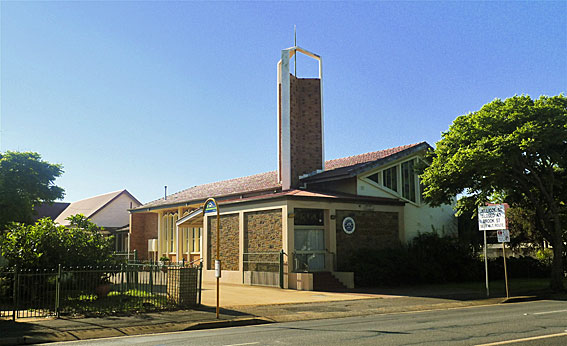
Pure Land Learning College
(formerly St Andrew's Presbyterian Church), Toowoomba
[Photograph by Trevor Bunning (November 2011)]

Pure Land Learning College
(formerly St Andrew's Presbyterian Church), Toowoomba
[Photograph by Trevor Bunning (November 2011)]
Historical and Technical Documentation by Geoffrey Cox
© OHTA 2011 (last updated November 2011)
Founded in 2001, the Pure Land Learning College in Toowoomba is a Buddhist institution that occupies the former St Andrew's Presbyterian Church in West Street. The land was purchased in 1907 by the congregation of St Stephen's Presbyterian Church for the purpose of a Sunday School, which was opened in 1908. The congregation became independent and known as 'St Andrew's' around 1912-13. The present building was opened in 1961. The congregation moved to a new site in 2001 when the building was sold to the Pure Land Learning College.1
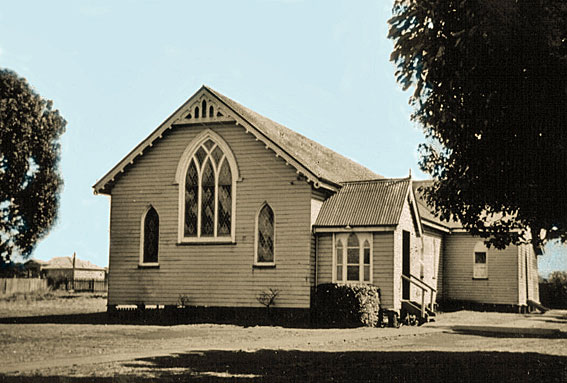
The original St Andrew's Presbyterian Church, Toowoomba
[Photograph by family of Bill Fraser (c.1949)]
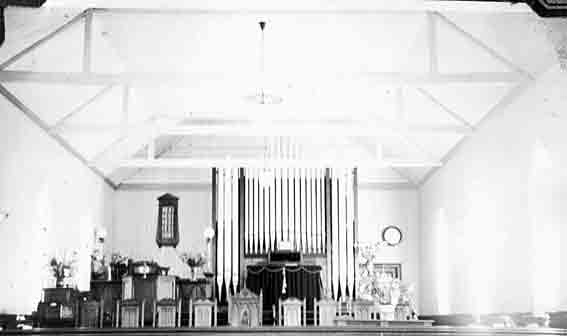
The 1935 Whitehouse Bros organ
in the former St Andrew's Presbyterian Church, Toowoomba
[Photograph by family of Bill Fraser (c.1949)]
The organ, which remains in the building, was built in April 1935 by Whitehouse Bros of Brisbane for the former church on the present site at a cost of £362.12.5.2 Reflecting the economic climate of the depression years, it initially comprised just four stops (two on each manual), although there was provision at the console for the addition of a Swell Gedact 8ft, Pedal Bourdon 16ft and Tremulant.
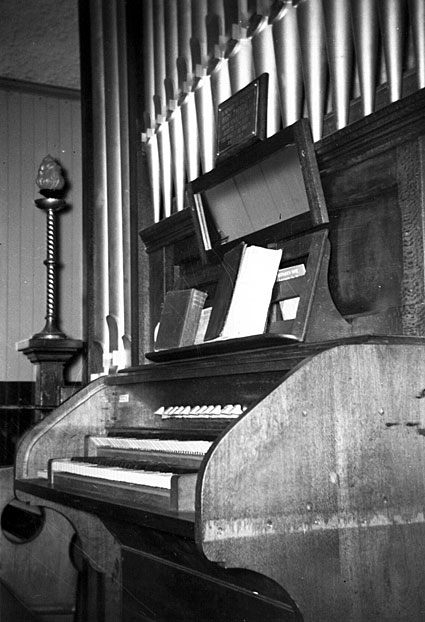
Console of the 1935 Whitehouse Bros organ in the former
St Andrew's Presbyterian Church, Toowoomba
[Photograph by Bill Fraser (c.1958)]
The instrument was moved to the present building by H.W. Jarrott of Brisbane in time for its opening in April 1961. Jarrott made two of the proposed additions (Swell Gedact 8ft and Tremulant) a few years later in 1964. There had been no internal preparation for enlargement of the organ, and a new chest was supplied for the Gedact at this time.3
The organ was enlarged in 1976 by Walter Emerson of Toowoomba. Emerson attempted to convince the church authorities at the time to electrify the action, but it remained tubular-pneumatic. Three of the four stops added in 1976 came from the 1909 B.B. Whitehouse & Co. organ, then at the Methodist Church, Toowong,4 and the new Octave 4ft came from Aug. Laukhuff in Germany. The two added Great stops were placed on a separate chest mounted on the wall to the right of the console. The remaining stops from Toowong went to Emerson's new organ for Peace Lutheran Church, Gatton, while body of the Toowong organ went to St Matthew's Anglican Church, Drayton.5
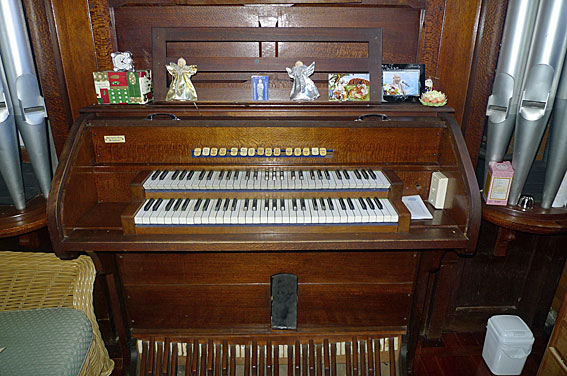
Console of the 1935 Whitehouse Bros organ
including stops added in 1964 and 1976
[Photograph by Trevor Bunning (November 2011)]
Since the congregation moved to another location in 2001, the organ has remained in the building, hidden behind a screen and no longer in use.6
| GREAT Open Diapason Dulciana Stop Diapason Octave SWELL Gedact Salicional Flute Oboe PEDAL Bourdon Bass Flute COUPLERS Swell to Great Swell to Pedal Great to Pedal Swell Octave to Great |
8 8 8 4 8 8 4 8 16 8 |
[1976; ex Toowong Methodist, 1909] [1976] [1964] [1976; ex Toowong Methodist, 1909] [1976; ex Toowong Methodist, 1909] [1976] |
Swell tremulant [1964]
Compass: 61/30
Pedalboard: radiating concave
Tubular-pneumatic action.7
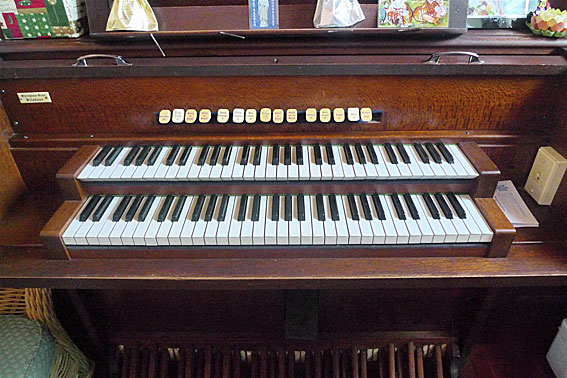
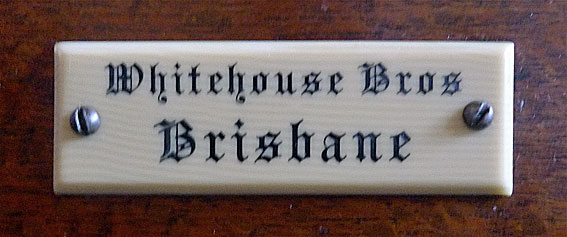

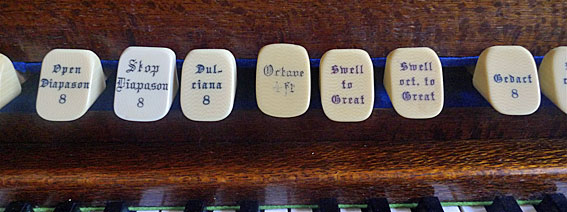
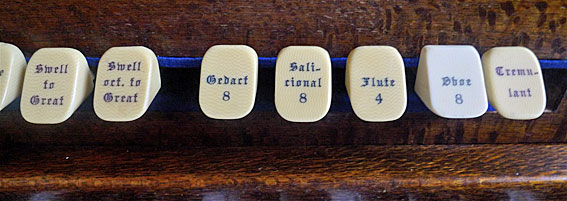
Console details and organbuilder's plate
[Photographs by Trevor Bunning (November 2011)]
_________________________________________________________________________
1. Downs Folk: Lives and Times of folk of Toowoomba & the Downs. http://downsfolk.wikidot.com/st-andrews-church-t - accessed November 2011.
2 Whitehouse Bros Ledger (1922-1940), p. 159.
3 Personal communication to G. Cox from H.W. Jarrott, February 1974; dates also supplied from church records by Rev. N.T. Barker, February 1974.
4 Personal communications to G. Cox from Walter Emerson, 1975-76.
5 Personal communication to G. Cox from Leslie W. Rub, June 2003. Rub also recalled that the original bottom octave of the Open Diapason from St Andrew's went to Gatton, being replaced at St Andrew's with a new stopped bass octave made by Emerson. The Toowong bass went to Drayton.
6 Personal communication to G. Cox from Leslie W. Rub, June 2003.
7 Specification noted by G. Cox, February 1974, incorporating subsequent changes supplied by Leslie W. Rub, June 2003.

[Photograph by Trevor Bunning (November 2011)]